Simply Economics November 19, 1999
By Evelina M. Tainer
Chief Economist, Econoday
Fed raises rates, stock market rallies
Fed rate hike appears bullish for equities
The Fed raised its federal funds rate target by 25 basis points this past week - unleashing a torrent of positive stock price movements. The Dow regained its 11,000 mark for the first time since September. The NASDAQ composite records new highs daily. Market players were looking for the NASDAQ to reach the 3000 mark. It did briefly - before surging past 3300. The NASDAQ composite is now nearly 54 percent higher than year-end 1998!

The S&P 500 closed at a new high on Thursday, but retraced a couple of ticks on Friday. It is approaching the Dow in terms of increases since the end of last year. Even the laggard Russell 2000 index posted five straight gains by Thursday to reach its highest level since mid-July. It edged down a tick on Friday, but has improved enough to show a 9.3 percent gain since December 31, 1998.
Treasury market dips after Fed move
It is not surprising that interest rates would rise after a Fed rate hike. But actually, the bond market was mostly anticipating the 25 basis point increase in the funds rate target. This mostly reflects a buy the rumor sell the fact mentality. Treasury securities had rallied the previous week to levels that weren't necessarily realistic given fundamentals. One of the major problems facing the Treasury market this past week was corporate supply. Treasury issues tend to suffer when investment-grade corporates come to market - because of their higher yield. The table below shows that Treasury securities rose by the same amount across the spectrum of maturities.
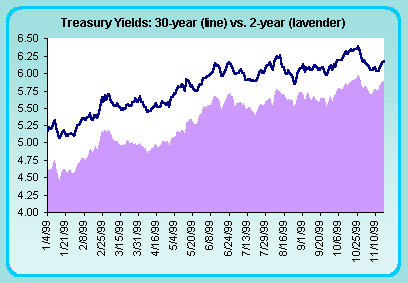
|
Markets at a Glance |
| Treasury Securities | 12/31/98 | November 12 | November 19 | Weekly
Change |
|
30 year Bond | 5.09% | 6.03% | 6.16% | +13 BP |
|
10 year Note | 4.65% | 5.93% | 6.06% | +13 BP |
|
5 year Note | 4.53% | 5.86% | 5.99% | +13 BP |
|
2 year Note | 4.53% | 5.76% | 5.90% | +14 BP |
| Stock Prices |
|
Dow Jones Industrial Average | 9181* | 10769* | 11004* | +2.2% |
|
S&P 500 | 1229* | 1396* | 1422* | +1.9% |
|
NASDAQ Composite | 2193* | 3221* | 3369* | +4.6% |
|
Russell 2000 | 422* | 450* | 461* | +2.4% |
| Exchange Rates |
|
Euro/$ | 1.1668 | 1.0316 | 1.0300 | - 0.2 % |
|
Yen/$ | 113.20 | 105.21 | 106.08 | +0.8 % |
| Commodity Prices |
|
Crude Oil ($/barrel) | $12.05 | $24.95 | $26.20 +5.0 % |
|
Gold | $289.20 | $292.10 | $295.80 | +1.3% |
| (* rounded) - (BP = basis points; stock price indices are rounded) |
|
FOMC raises fed funds rate target and discount rate quarter point
Aside from economic indicators, this week's FOMC meeting was the key event. Fed officials voted to raise the federal funds rate target by 25 basis points to 5.50 percent. At the same time, the Fed also increased the discount rate by 25 basis points to 5.00 percent. They adopted a symmetrical stance to policy. This was a change from the October meeting where a tightening bias was favored.
In announcing the rate hike, they noted that "cost pressures appear generally constrained…" and therefore risks to growth persisted in light of tight labor markets. They also focused on the fact that economic growth was exceeding its potential.
The bottom-line on further Fed action? It is well established in the financial community that the Fed would not dare raise interest rates in December for fear that some Y2K bug will create distortions. The next FOMC meeting will take place in the first two days of February. At that point, potential Y2K disruptions are not likely to be problematic. Yet, it will be too early to see an impact from the most recent rate hike. In any case, market participants are generally relieved that this rate hike was done and don't expect to see any additional hikes for awhile (barring scary inflation figures).
Consumer inflation on target
The consumer price index rose 0.2 percent in October, half as much as September's hike, and the smallest monthly gain in four months. This kept the year-over-year change at 2.6 percent for the second straight month and the highest two-month reading since March and April 1997. Generally, the acceleration in the past several months is attributable to higher energy prices. These did dip 0.1 percent in October, but remain 10.2 percent higher than a year ago.
Excluding the volatile food and energy component, the CPI also rose 0.2 percent in October and held the 2.1 percent year-over-year gain. In contrast to the total CPI, this core component is actually in a more moderate phase than a couple of years ago.
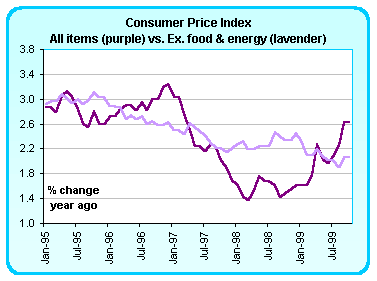
It is interesting to note the sharp variation between prices of goods and services. Prices of goods fluctuate more wildly based on supply and demand conditions. Also, the goods component hold the lion's share of energy costs. The chart below shows how prices of services are tilting ever so slowly downward. Prices of goods have skyrocketed (this is a relative term given the yearly rise under 3 percent) because of oil and tobacco prices. Although tobacco prices fell 0.6 percent in October, they are a whopping 31 percent higher than a year ago.
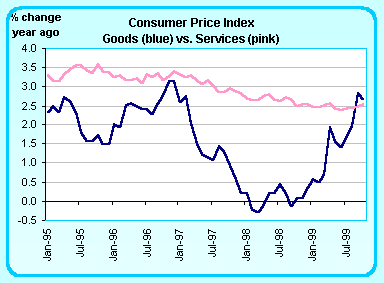
Economists have a (bad) reputation for removing "special factors" from the CPI to show that underlying inflationary trends don't really exist. But one has to admit that while oil prices do affect the majority of consumer's daily expenditures, tobacco prices don't.
The bottom-line on inflation? Producer prices have shown some acceleration in recent months, but this hasn't carried over to consumer prices. This means that producers may be seeing narrower profit margins. Incidentally, given the tight labor markets, one would expect faster acceleration in the prices of services where labor costs are more important. Yet, prices of services are moderating still. The jury is still out on when inflation will begin to speed up - or even if it will.
International trade worsens
The international trade deficit on goods and services widened by $1.1 billion in September to $24.4 billion. Exports fell 0.9 percent during the month after a healthy 4.2 percent hike in August. This drop was anticipated as aircraft shipments decreased from strong August levels. At the same time, imports edged up a meager 0.1 percent increase after rising 1.9 percent in the previous month. Both exports and imports posted year-over-year gains that were modestly lower than August.
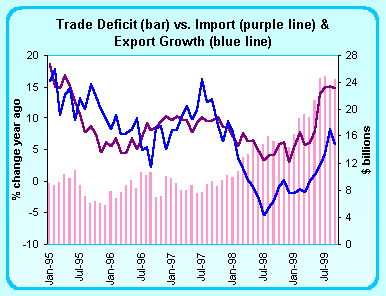
The bottom-line on international trade? While the trade deficit is not likely to return to 1995 levels any time soon, its worsening pace may have stalled. The deficit has maintained roughly the same level for the past four months. Exports have jumped sharply and improving economies abroad portend further gains in coming months. Remember that the U.S. has an insatiable demand for imported goods, so import demand may not drop off much.
Housing continues on moderate path
Housing starts edged up 0.1 percent in October to a 1.628 million unit rate, but are down 4.1 percent from year ago levels. Starts of multi-family units dropped 10.1 percent for the month and are reflecting a 24.3 percent decline from last October. In contrast, single family starts rose 2.8 percent this month and are 2.1 percent higher than a year ago. This may be reflecting a greater demand for homeownership in this booming housing market.
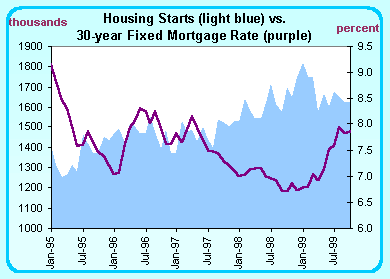
The bottom-line on housing? Housing starts probably peaked early this year. But they could well remain near current levels despite a one-percentage point increase in conventional mortgage rates between January and October. When interest rates start to drift higher, consumers are more likely to choose adjustable rate loans than fixed rate loans and enjoy lower rates.
Industrial production recovers after Hurricane Floyd
Industrial production jumped 0.7 percent in October after dipping 0.1 percent in the previous month. Hurricane Floyd had beat up the utilities component - which rebounded in October. Manufacturing production also picked up speed in October - rising at its fastest pace in a year! This increased production is going hand in hand with the gains we have seen in exports.
It is interesting though, after all the talk on inventory building to advert Y2K disruptions, the yearly rise in inventories are not accelerating very quickly. Moreover, the inventory-to-sales ratio is actually in a steep descent. Perhaps this means that we could see some larger gains in production in coming months as inventory stocking truly begins.
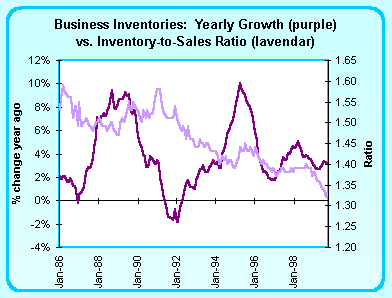
The bottom-line on production? Industrial production picked up steam in October. This partly reflected a recovery from the dampening impact of Hurricane Floyd last month. Yet, as producers talk of building inventories to alleviate disruptions, this could mean faster production in coming months. After all, near term inventory levels appear anemic.
THE BOTTOM LINE
The Fed raised rates for the last time this millenium (sorry, couldn't resist). Market players will be forced to monitor economic conditions closely because the Fed specifically cited that they were concerned about the rapid growth of the economy - which is exceeding its potential. Market players will also continue to monitor inflation indicators very closely.
Looking Ahead: Week of November 22 to 26
We use the Market News Service survey of forecasts to describe the market consensus.
Monday
The consensus forecast is showing a $26 billion federal budget deficit for October, the first month of FY2000. This would already start the new fiscal year on a lower track than the past two years.
Tuesday
New orders for durable goods are expected to rise 0.5 percent in October after a 1.3 percent drop last month. This reflects a gain in aircraft orders. Excluding the volatile components, most economists are looking for a moderate gain. The upward drift in new orders continues, though.
Wednesday
Market participants are expecting new jobless claims to decrease 2,000 in the week ended November 20 from last week's 287,000. Claims remain range-bound.
The consensus forecast is showing an upward revision to the Commerce Department's third quarter estimate of real GDP. Initially, real GDP rose at a 4.8 percent rate; economists are looking for a 5.2 percent growth rate after new data on inventories and net exports are taken into account. The implicit price deflator is not expected to change from a 1 percent pace.
Friday
Economists are predicting personal income to rise 0.6 percent in October after remaining unchanged in September. This is a partial recovery from the impact of Hurricane Floyd last month and reflects the spurt in nonfarm payrolls. At the same time, personal consumption expenditures are expected to increase 0.3 percent for the month, about the same as last month. This reflects anemic spending on durables, but stronger gains in nondurable goods and services.
|








